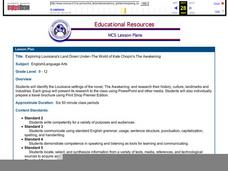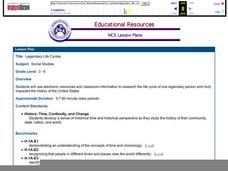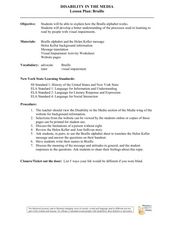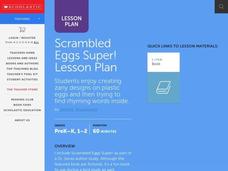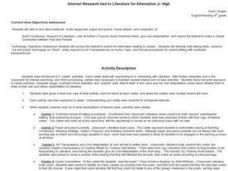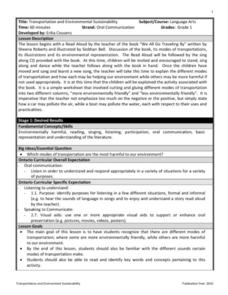Curated OER
What is a Make Believe Story?
Explore the concept of make believe stories. In this genres of literature instructional activity, students discover the difference between realistic fiction and fantasy. They are asked questions during and after the reading of a book to...
Curated OER
What's In a Name?
Learners explore the relationship between names and certain cultures and locations. In this identity lesson, students create family migration or immigration maps. Learners read excerpts from When My Name was Keoko and Lost Names: Scenes...
Curated OER
Exploring Louisiana's Land Down Under - The World of Kate Chopin's The Awakening.
Visit 19th century Grand Isle, Cheniere Caminada, and New Orleans! Meet the inhabitants, learn about their history and culture, and view landmarks and industries! After reading Kate Chopin’s The Awakening, class groups research the...
Curated OER
Advocates for Disabilities
Students research people who have contributed to making life better for the disabled. In this advocacy lesson students enter the names of advocates on cards and divide into groups. Students complete a worksheet...
Curated OER
Legendary Life Cycles
Upper elementary historians research a legendary person who had an impact in the the history of the United States. Learners research the life of their person of choice, and construct a legendary timeline using computer software which...
Curated OER
Creating a Costume Book for the Opera Don Pasquale
Students listen to and watch the opera, Don Pasquale, by Donizetti. They discuss the importance of sets and costumes in an opera and then, with a partner, design a period costume for each of the main characters in the opera.
Curated OER
Disability in the Media Lesson Plan: Braille
Students determine the workings of the Braille alphabet and how people with visual impairments learn how to use it. In this Braille lesson, students study the associated vocabulary, read about Helen Keller, and complete associated...
Curated OER
Day and Night
Good Night, Moon is a classic little ones absolutely love. It's a sweet book that can be used, as in this instructional activity, to start a conversation about the difference between night and day. After reading the story, the class...
Curated OER
The Tale of Peter Rabbit
Students practice their reading comprehension while investigating vegetables. In this children's literature lesson, students are read The Tale of Peter Rabbit in class and analyze the concept and themes. Students complete...
Curated OER
Elements of Myth
Students read and act out myths. In this world mythology lesson, students read and analyze myths from various cultures and then recognize their attributes as they prepare presentations of myths that explain natural phenomena.
Curated OER
Recycling!
The students recall events from Dr. Seuss' story The Lorax and make connections to environmental issues affecting their lives. They are expected to reflect on the facts of the story and respond verbally stating the inferences they made...
Curated OER
Mixing Colors with "Little Blue and Little Yellow"
Students mix colors to make new colors. In this color mixing lesson, students listen to Leo Lionni's Petit Bleu et Petit Jaune, before retelling the beginning, middle, and end of the story. They watch as the teacher mixes food coloring...
Curated OER
Scrambled Eggs Super!
Students study rhythm and rhyme. In this rhyming lesson, students read Scrambled Eggs Super! by Dr. Seuss. Students explore the rhythm of rhyming words found in the book. The students decorate eggs and place rhyming words inside to use...
Curated OER
Internet Research tied to Literature for Alternative Jr. High
Ninth graders research a career using different "center" activities and then write a paper.
Curated OER
Analysis of Character in a Short Story
Ninth graders examine a character from the short story, John Steinbeck's, "Flight." students respond to questions about the story and illustrate the character's journey.
Curated OER
What Makes the Writer Write?
Students study Charles Dickens's Great Expectations to gain insight into a classical piece of fiction and to explain how writers respond to social conditions. They also consider how that response is important today.
Curated OER
Night of the Twisters KW Chart
In this literature response worksheet, young scholars read The Night of the Twisters and then complete a KW table. Students record what they know about tornadoes and what they would like to learn.
Curated OER
Helping Disabled Dogs
Students read a story called Carts Give Mobility to Disabled Dogs and answer vocabulary and comprehension questions about it. In this current events lesson plan, students respond to literature by answering questions, recalling details,...
Curated OER
U.S. Population Hits 300 Million
Students read a story about the population in the United States reaching 300 million, and answer vocabulary and comprehension questions about it. In this population lesson plan, student respond to literature by answering questions,...
Curated OER
Meteor Showers!
Learners read a story called Orionid Meteors to Shower Earth and answer vocabulary and comprehension questions about it. In this meteor shower lesson plan, students respond to literature by answering questions, view Sky Maps online, and...
Curated OER
Old Mayan Mural
Students read a story called Scientists Discover Oldest Mayan Mural and answer vocabulary and comprehension questions about it. In this current events Mayan mural lesson plan, students respond to literature by answering questions,...
Curated OER
Transportation and Environmental Sustainability
After listening to the book, We All Go Traveling By, 1st graders discuss different modes of transportation that they see out in the world, and the environmental impacts of each one. Kids work together to create a list of the types...
Curated OER
The Role of Money
Fourth graders examine the role of money. In this money lesson, 4th graders read a chapter from Judy Blume's, Double Fudge, to see how money is made and how people make money. They finish a worksheet, and play a game about money.
Curated OER
Swallowing Stones by Joyce McDonald Unit Plan
Students read Joyce McDonald's, Swallowing Stones while investigating the literary elements used in the writing. They define a large number of vocabulary words to be applied when reading. Finally, they write a persuasive essay.
Other popular searches
- Response to Literature
- Response to Literature Essay
- Theme Response to Literature
- Response to Literature Genre
- Responses to Literature
- A Response to Literature
- Avid Response to Literature
- Free Response to Literature
- Writing Response to Literature
- Literature Responses
- Night Responses to Literature
- Short Response to Literature


